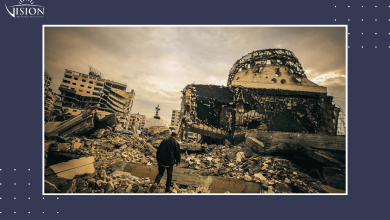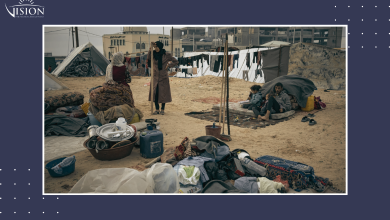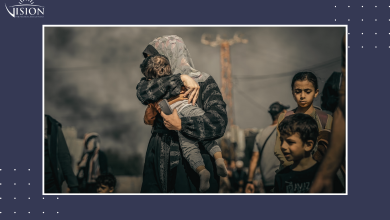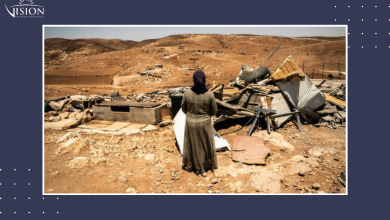The Occupation’s Ongoing Efforts to Forcibly Displace Gaza, Both Before and After October 7

Kareem Qurt
Yoav Shurak published his article, “Gaza: A Dream with a Window for Emigration,”1 in the tenth issue of Hashiloukh2(June 2018). The timing of its publication appears to be the primary motivation behind translating and presenting it to Palestinian and Arab readers. In the piece, Shurak—an Israeli researcher, writer, and journalist, and a graduate of Yeshivat Merkaz Harav3 (a fact that clearly indicates his ideological background)—proposes a vision for resolving the “refugee problem,” which he views as a core reason for the perpetuation of conflict and the severe hardships afflicting the Palestinians. His proposal, however, does not seek to establish a permanent, just solution to the refugee issue; rather, it explicitly advocates for the resettlement of refugees in diaspora countries, the dissolution of UNRWA, and the expulsion of remaining Palestinians (whether officially designated as refugees or not) from the rest of Palestine.Although Shurak focuses exclusively on the Gaza Strip, it is clear—as will be shown—that Gaza merely serves as a testing ground for the entirety of Palestinian geography.
It is noteworthy that, in recent years, Israelis have shown a growing appetite for “encouraging emigration” from Gaza or orchestrating its mass expulsion. This phenomenon dovetails with extensive polling and statistical data indicating that a high percentage of young Gazans wish to leave in search of improved livelihoods and career opportunities. The translated article featured here exemplifies an Israeli mindset obsessed with displacing the Palestinian people by any means possible. Admittedly, this obsession is most visible among the religious and nationalist strands of the Israeli Right, though it is less apparent (though by no means absent) among the center-right and what remains of the Zionist Left. One must recall that Israeli society as a whole has shifted rightward in recent decades, such that most of its political currents now vie for power within an overtly right-wing arena. It bears emphasizing that the idea of displacing Palestinians is hardly a recent invention of Zionist thought; its foundational premise has always been the necessity of uprooting the indigenous population. Likewise, this notion is far from new among religious Zionists, whose political influence has grown steadily since the 1970s. In 1980, for instance, Rabbi Meir Kahane published his book A Thorn in Your Eyes4, which centers on the imperative of expelling the Palestinian population, including those living in the territories occupied in 1948. Kahane even recounts how he proposed to residents of certain Palestinian villages inside the Green Line the option of collective, voluntary migration.
Today, Kahane’s ideological heirs within the religious Zionist movement—most prominently Bezalel Smotrich and Itamar Ben Gvir—are striving to translate his vision into official policy and tangible measures, many of which have already been realized. Indeed, the concept of “voluntary transfer” has gained significant traction in Israeli society, aided by their efforts, particularly in the wake of the genocidal war against the Gaza Strip. Yet the idea of displacing the Palestinian people did not suddenly emerge after 7 October 2023, nor did calls to eliminate UNRWA. Furthermore, this discourse is not limited to a single article or policy paper of negligible practical influence. Rather, it reflects sentiments widely shared by the broader Zionist Right—one that includes multiple factions on Israel’s political spectrum.
In recent years, these ideas have moved beyond mere speculation or ideological rhetoric: they have increasingly taken the form of concrete initiatives and even official political programs aimed at expediting the displacement of Palestinians. In 2019, for example, while serving as a Knesset member, Smotrich declared that if he had his way, he would reoccupy the Gaza Strip, disarm all armed groups, and open the territory’s gates to large-scale emigration. It is likely no coincidence that his so-called “Decisive Plan,” which proposes similar measures, appeared in the sixth issue of Hashiloukh(September 2017), where it was presented under the title “The Decisive Plan: The Right’s Key to Peace.”
For readers encountering Shurak’s essay today, little within it may seem novel, as much of its content is currently unfolding on the ground. A retrospective reading, however, reveals important insights: the scheme to expel Gazans was not conceived post-7 October 2023, nor was the effort to abolish UNRWA. Moreover, such proposals are not isolated to a single article that may or may not shape governmental policy; rather, they represent a significant trend in contemporary Israeli political thought and action. In recent years, there has been a marked evolution from ideologically driven essays to concrete proposals and official plans aimed at achieving this objective.
In 2018, the “Derekh Hayyim” [5] (“Way of Life”) movement presented a plan to solve the “Gaza problem.” This plan, published on the movement’s website (no longer accessible) and its social media pages, as well as on the “HaKol HaYehudi” (“The Jewish Voice”) site affiliated with the Hilltop Youth, was titled “Gaza: Rethinking the Path—Decisive Action, Occupation, Education, Emigration.” It rested on four pillars as indicated by its title, yet its fundamental aim lay in displacing the Gaza Strip by any means possible, with a specific emphasis on encouraging emigration. This encouragement would involve imposing a complete and suffocating siege, during which the entry of water, electricity, and food into the Strip would be halted, while simultaneously opening channels for departure—supported financially and logistically by Israel—without regard for the final destination of those leaving. The next phase would be reoccupation, conducted via a scorched-earth policy that labels anyone remaining in Gaza as a “terrorist,” culminating in absolute subjugation of the Strip and the departure of its last Palestinian inhabitant. Whether the current events in Gaza, beginning with the genocidal war launched after Operation “Al-Aqsa Flood,” followed any part of this plan is unclear, nor can one ascertain if the plan itself merely reflects a Zionist mentality. The more plausible assumption is that intellectuals and their ideas emerge from a particular environment, reflecting their society’s mindset.
In 2019, an unnamed Israeli official declared that the occupying state was prepared to allow Gaza residents to emigrate and would offer them various facilitations, including the use of an Israeli airport in the Negev for their departure. This proposal had reportedly been raised multiple times before the Cabinet. He also mentioned that they had approached several countries in the Middle East and elsewhere to persuade them to accept Palestinian migrants, but the primary obstacle was that no state was willing to receive them.
Returning to the translated article, the author justifies his call for Gazans to leave on the grounds that they themselves wish to do so, that Gaza is overcrowded, and that it offers no hope or viable opportunities for work or a better life. While it is true that Gaza suffers from these hardships, the author never comes close to mentioning the reasons behind the conditions it endures. Instead, he treats Gaza’s humanitarian catastrophe as though it were an intrinsic fact of the Strip, devoid of any acknowledgment of occupation or displacement from the lands of 1948. More disturbingly, he makes no reference whatsoever to the devastating Israeli blockade, the principal factor rendering Gaza utterly without hope or opportunities. Equally conspicuous is his omission of how Israel has long controlled Gaza’s unemployment and poverty rates, as well as its overall prospects for growth and development, and how the goal of forced displacement often drives Israel’s policy choices—although temporary security considerations can occasionally prompt some easing of restrictions. In fact, Israel, by a mere decision, could lower Gaza’s unemployment rate; likewise, through calculated policy, it has maintained that rate at no less than 50%. Even more egregious was the plan proposed by Israel following its 1967 occupation of the Strip, suggesting the draining of Gaza to destroy what was left of its fragile agricultural sector, thereby depriving Palestinians of any possibility to remain.
Throughout the years of blockade and repeated assaults on Gaza—and even before then—the occupying state created the objective conditions for a suffocating humanitarian crisis and an environment designed to drive residents away. These efforts bore fruit in waves of emigration, or more accurately escape, whether through the Rafah crossing—especially after it reopened in 2017—by perilous boat journeys, or through the permits the occupier grants for travel to the West Bank, which can serve as a final destination or merely a transit point en route to other countries. Against this backdrop, if we examine the translated article through a predictive lens, we see that today’s reality in the West Bank and its future mirror Gaza’s situation prior to October 7, 2023. Presently, the West Bank is subject to policies, measures, sanctions, and meticulously engineered economic crises, accompanied by the expansion of settlements led by settlers whose escalating violence has turned lethal [6]. These settlers do not shy away from declaring that their goal is to force Palestinians to leave, actively carrying out this violence to achieve precisely that end.
What the occupation is currently doing in the West Bank is creating the concrete conditions for displacing the Palestinian people under the label of “voluntary emigration,” namely the kind prompted by the collapse of life opportunities and the severe deterioration of economic conditions, along with a fundamental sense of existential anxiety and a perpetual fear of traveling through checkpoints. The fear arises either from wasting countless hours waiting in line or being subjected to abuse at the hands of occupation soldiers—and potentially detained—or from falling prey to settlers’ violence on roads and streets. These accumulative factors and many others push people to feel as though they are confined in a vast prison, leaving them to contemplate only how they might escape it.
Eventually, Israelis will offer theoretical justifications for why West Bank residents want to abandon their homeland and seek better opportunities in countries that welcome immigrants, citing the lack of prospects for a decent life, employment, and security in the West Bank. This mirrors the rationalizations once used for Gaza prior to the genocidal war, a discourse that has intensified and turned into an undeclared strategy since the war.
Below is an article presenting a variety of Israeli arguments and ideas that aim to legitimize the displacement of Palestinians, specifically in the Gaza Strip. Familiarity with these notions is crucial to understanding the undisclosed modus operandi of the Zionist mindset—particularly the right-wing sector fixated on deportation—of which this article is a prime example.
Translation of the article:
There may be good reasons to restrict certain goods from entering Gaza, yet there is no justification for compelling its densely packed population to remain there.
Opinion polls suggest that half of Gaza’s inhabitants would leave if given the chance. This finding, reported by The Washington Post last year (August 6, 2017), indicates that the percentage is higher among young people. Mohammed Hameed, aged 24, told reporters, “I don’t believe these polls. If the opportunity arose, every young person would leave.” This sentiment was confirmed once more a year later in a report by journalist Ohad Hamo on Israeli television (main news broadcast, May 14, 2018), where Youssef Hamad—a resident of the Zaytoun neighborhood and a university graduate who tries to make ends meet by selling coffee at the beach—stated, “It’s not just the young who want to emigrate. If the crossing were opened even by two centimeters, everyone would rush out of Gaza.”
The same report shows that Gaza is one of the most densely populated areas on the planet, underscoring the ongoing tragedy of a region plagued by astonishing unemployment rates, particularly among young people, including those with university degrees and professional skills.
These circumstances raise a fundamental question immediately: If Gaza is overcrowded with qualified, employable individuals but offers them no future, if it is cut off between Israel and Egypt without any avenue for international trade, if its governing authority traps its residents in a conflict that promises only despair and failure, and if young people want to leave the moment they have the opportunity—then why is that opportunity denied to them?
Indeed, to emigrate from Gaza, one must first reach an airport or seaport in Israel or Egypt. Yet this is not the true reason that emigration does not occur. Were Gaza’s youth to have destinations willing to receive them, it would be feasible to arrange their passage to the ports. Hence the more important question: why, in a world that strives to accommodate millions of migrants from other troubled countries, is no opportunity offered to Gaza’s residents? How is it possible that Gazans’ suffering succeeds in attracting considerable global aid, even prompting international pressures and condemnations of Israel, yet fails to spur the West to offer them migration prospects and resettlement, to grant deserving individuals a path to a new life, and to pressure Israel and Egypt to allow them to leave the Strip?
This question takes me back nearly a decade, to when I met in Jerusalem with a European Union relief delegation for Gaza, as part of my work presiding over the “Israeli Initiative.”[7] This delegation was funneling substantial funds and assistance for Gaza’s reconstruction following Operation “Cast Lead.”[8] Even then, surveys indicated that half of Gaza’s population wished to emigrate. When I presented these findings to one of the French representatives, who had spent considerable time in Gaza and felt a genuine desire to help the poor and the oppressed, he laughed and said, “Half of them want to leave? They all want to leave.”
I asked him, “Then why not help them do so?” The European was briefly taken aback, but his reply remains etched in my mind to this day: “Because if their problem is solved elsewhere—meaning that the refugee crisis no longer exists—it implies relinquishing political demands and ceasing to hold Israel responsible for making them refugees in 1948.”
I suggested that I would have the State of Israel formally acknowledge its guilt and responsibility for the refugee issue if that was the stumbling block, after which we would enable these desperate Gazans to exit the Strip and reach new destinations. My proposal caught the French delegate off guard, and he did not know how to respond.
His reaction, in the third millennium, reminded me of the traditional Arab rejection from the 1960s of any resolution to the refugee problem—rooted in the belief that refugees from the War of Independence [the Nakba] should not be rehabilitated or resettled, lest the Palestine question be dissolved.
It dawned on me then that while the international community provides food and medicine to Gaza’s inhabitants, and while warmongers from the Shiite world supply them with weapons, no one is giving a million Gaza refugees any hope. Had there been an international organization assisting entire Gazan families to emigrate and forge better futures elsewhere, the situation would look entirely different, both for Gazans and for Israel.
Instead, UNRWA—an agency that perpetuates the refugee issue (and never attempts to rehabilitate refugees and their descendants)—together with Palestinian organizations and their sponsoring states, continue to instill the illusion of “return” among Palestinians. These romanticized, demonic notions revolve around the idea of destroying the Jewish state and restoring refugees to lands that were desolate and barren during their presence there—lands they now envision as a veritable Garden of Eden.
It is important to recognize that the narrative invoked by Europeans—together with UNRWA and the Arab states—to justify their refusal to solve Gaza’s problem by opening the door to emigration is not one of “national belonging,”[9] which would regard organized emigration as depriving people of their homeland. Rather, it is the narrative of the “right of return.” Yet this is not the genuine reality. Unlike the Arabs of Judea and Samaria [the West Bank], the vast majority of Gaza’s population descends from refugees originating inside the Green Line; they do not harbor a sense of national attachment to the Strip where they were born. In their view, they were merely born in one of Gaza’s cities because of a historical catastrophe [the Nakba], and their lost homeland still lies behind the borders. They continue to pass down from one generation to the next the stories of Ramla and Jaffa, of Qastina[10] and al-Masmiyya,[11] all of which remain beyond their reach. For them, Gaza is only a transitory station, mired in suffering for many long years; hence, leaving it becomes an understandable and justifiable goal.[12]
Merely assigning blame to the Arabs, UNRWA, and the rest of the world does not offer a constructive solution. True, Israel can candidly argue that had the Arabs assisted their refugee brethren—just as Jews assisted their own who became refugees from Arab countries[13]—the refugee issue would by now be a thing of the past. Gaza likewise would not be the “pressure cooker” it is today. Yet shifting blame to the other side, no matter how warranted, runs counter to effective policy and strategy. Nor can one shake the impression of a “poor Samson”[14] strategy that depicts Israel as a victim of circumstances beyond its power to change.
In reality, the opposite holds true: the very existence of the State of Israel stands as an example of willingness to bear responsibility and alter circumstances. It could have, and still could, transform the situation at its core—had it not repeatedly chosen to evade its responsibilities toward the refugee issue in general and Gaza in particular. Israel elected to withdraw from Gaza and leave its problems behind the wall, clinging to the delusional notion of “We are here, and they are there.” It did so out of a deeply ingrained fear of confronting the longstanding refugee problem and of acknowledging the price that others paid for the establishment of Israel. It was equally afraid—no less so—of “ruling another people” and of dealing with the complex challenges bound up with that.[15]
Israel could have adopted a strategy aimed at weakening UNRWA, yet did not do so. It might have worked to rehabilitate [resettle] the refugees and enabled Gazans willing to leave the cycle of poverty to start new lives elsewhere, but again, it did not.
In their book The War of Return (Dvir, 2018), Adi Schwartz and Einat Wilf reinsert the forgotten and neglected issue of refugees and UNRWA into the daily agenda and public discourse. This issue carries extensive implications for the legitimacy of the State of Israel and for its capacity to end—or at least mitigate—the conflict in the Middle East. Their work is an important and candid contribution, openly acknowledging Israel’s responsibility for making decisions in this domain.
Israel still possesses the capacity to adopt policies for rehabilitating [resettling] refugees and facilitating Gazans’ emigration. Such a course would break with outmoded modes of thinking, and because it would represent a genuine breakthrough, it would inevitably unleash certain “genies from their bottles.” While the anticipated consequences might be significant, perpetuating cycles of violence and leaving Gaza as a barren territory devoid of hope bode even worse. Unlike the situation in Syria, regarding which Israel’s policy of nonintervention was a prudent choice, abandoning Gaza to its fate constitutes both an ethical and a strategic error.
The prudent and equally justified step for Israel would be to fulfill the wish of Gaza’s residents to escape the “pressure cooker” in which they live, and to adopt a rapid, effective course of action to improve conditions in the Gaza Strip—by opening its gates to large-scale emigration to other parts of the world where opportunities are far greater. Incidentally, we are not reinventing the wheel here. The funds required for this project already exist, but they are allocated each year to UNRWA, the agency that has succeeded in keeping refugees as refugees for four generations after that long-ago war [the Nakba]. If the Government of Israel wishes to make a historic contribution to the Zionist endeavor and to peace in the Middle East, it would do well to dare to “tamper with” this pressure cooker and free it.
[1] The original title is “עזה: חלום החלון לים התיכון” (literally, “Gaza: The Dream of the Window to the Mediterranean”). The author chose this title as a stylistic embellishment due to the rhyme in Hebrew (transliterated as: “Halom Haḥalon L’yam Hatichon”). A literal translation does not convey the intended meaning. [2] Hashiloukh began publication in 2016 through the Israel Freedom Center (previously known as Keren Tikvah, or “Hope Foundation”), which to some extent espouses the “neoconservative” school of thought: it aims to promote free-market policies, privatize state functions, and limit governmental powers, while simultaneously fostering a conservative ethos in Israeli society based on Jewish traditions. This journal was named Hashiloukh after a Jewish periodical of the same title published by the Jewish leader Asher Zvi Ginsberg—founder of the “spiritual Zionism” current—who wrote under the pen name “Ahad Ha’am” (“One of the People”). The earlier Hashiloukh journal was issued in Europe from 1896 to 1926 and took its name from a Jerusalem spring mentioned in the Book of Isaiah, chapter 8; in Arabic translation, it is called “Shiloh.” Although the present-day Hashiloukh is a relatively new journal, it has attracted prominent politicians as contributors, such as Israeli President Reuven Rivlin, Yair Lapid, Ayelet Shaked, and naturally Bezalel Smotrich. Yoav Shurak, the author of the article translated here, served as its editor-in-chief from its founding until March 2024. A quarterly publication, the journal carries right-leaning, religious Zionist tendencies, reflecting the ideology of the center behind its publication, as well as its editor, who is a graduate of Yeshivat Harav and an inheritor of Rabbi Kook’s legacy. [3] The world’s central “yeshivah” (rabbinical seminary) known as Merkaz Harav is the first religious Zionist yeshivah in occupied Palestine, regarded as the “mother of Zionist yeshivot.” It was established by Rabbi Abraham Isaac HaKohen Kook in 1924; he and his son, Rabbi Tzvi Yehuda Kook, stand out as the foremost founders and theorists of the religious Zionist movement. Yeshivat Merkaz Harav served as their ideological stronghold and that of religious Zionism in general. [4] See the book’s translation: Meir Kahane, A Thorn in Your Eyes, trans. Ghazi al-Saadi (Amman: Dar al-Jalil, 1985). [5] This is a Zionist association within the religious Zionist current, founded in 2010 to realize the vision of a “Jewish state grounded in the Torah of Israel,” and it calls for establishing a halakhic (religious-law-based) monarchy. It was founded and is presided over by Rabbi Yitzhak Ginzburg, head of the Od Yosef Chai yeshivah in the Yitzhar settlement south of Nablus. Among its members is Rabbi Yitzhak Shapira, the director of the same yeshivah—an institution widely recognized as a breeding ground for Jewish terrorism and a launchpad for Hilltop Youth. Shapira is also one of the authors of Torat HaMelekh (“The King’s Torah”), which advocates the permissibility of killing “goyim,” here referring to Palestinians. Another member is Tzvi Sukkot, a Hilltop Youth figure who became a Knesset member on the Religious Zionism list led by Bezalel Smotrich.Looking, for instance, at the number of settler attacks on Palestinian villages and towns during 2024—which exceeded 6,600—and comparing it with the figure for 2023, which stood at roughly 2,400 (an already very high number that has been steadily rising in recent years), one notes that 2024 witnessed an explosive surge in the frequency of these settler assaults. This is without even addressing their scale or nature.[6] [7] This was a personal initiative proposed in 2002 by then-Israeli Minister of Tourism, Binyamin Elon—a rabbi from the religious Zionist movement, a leading settler figure, and head of the Moledet Party. Elon’s initiative, known as the “Israeli Initiative,” seeks a regional solution to the “Israeli-Palestinian” conflict based on annexing the West Bank to the occupying state, displacing its inhabitants to Jordan, dismantling the Palestinian Authority and UNRWA, and resettling Palestinian refugees in foreign countries or in the states where they currently reside.
[8] Operation “Cast Lead” was a military offensive waged by Israel against the Gaza Strip between December 27, 2008, and January 18, 2009, officially aimed at halting rocket fire from the Strip. It began with intense aerial bombardment, followed by a ground incursion, and lasted for 23 days, resulting in the martyrdom of around 1,500 Palestinians—most of them civilians—as well as widespread destruction of Gaza’s infrastructure. Israel used internationally prohibited weapons during the assault, including white phosphorus, sparking widespread international criticism and accusations of war crimes. [9] The author originally used the term מקומיות (mekomiyot), which denotes belonging or a relationship binding people to a particular locale. The closest concept in Arabic is “nationality” or “national belonging.” [10] A Palestinian village depopulated in 1948, located about 38 km northeast of Gaza. [11] A Palestinian village depopulated in 1948, situated about 41 km north of Gaza. Two villages share this name—the larger al-Masmiyya and the smaller one—lying relatively close to each other. [12] The author here overlooks the fact that refugees’ constant references to their original towns and villages—places from which they were forcibly displaced—expresses their aspiration to return there, not merely to emigrate from Gaza to anywhere else. [13] It is worth noting that Zionist narratives assert that Arab Jews who migrated from Arab states to Palestine—becoming settlers, colonizers, and occupiers—were themselves “refugees” received by the “Jewish state.” This narrative thus posits that there was a mutual exchange of refugees between Arabs and Jews, and that the Arabs must address the Palestinian refugee issue in the same way the “Jewish state” resolved it by integrating Jewish refugees into society. Yet such a narrative flagrantly distorts reality. While the occupying state worked to bring Jews from around the world to Palestine—at times resorting to acts of terror in certain Arab countries in order to spread fear and push their Jewish communities to emigrate—neither the Arab states nor the Palestinians themselves wished or intended to leave their homeland, from which they were instead expelled and forced into exile. If the occupying state regards the Jews who settled there as refugees, then logically it should demand their return to their homelands; instead, it seeks compensation for their abandoned properties in Arab countries. [14] “Poor Samson” is a term coined by Prime Minister Levi Eshkol in the 1960s, originally articulated in Yiddish as “דער נעבעכדיקער שמשון” (der nebekhdiker Shimshon). This term carries a mocking undertone, since Samson is a “legendary” biblical figure who served as one of the Judges of the Children of Israel, famed for his superhuman strength granted by the Almighty—hence his moniker “Samson the Mighty.” Eshkol’s branding of him as “poor Samson” was intended to characterize Israel’s foreign policy strategy: while Israel is extremely powerful, it feigns weakness before the world to rationalize its aggressive actions and elicit sympathy for the “Jewish state” in light of its alleged victimhood. [15] It is important to note that Zionism, from its inception, has relied on twisting words from their contexts, falsifying historical facts and events, and rewriting history in forms of narratives that, in some cases, are so flimsy as to be absurd, while in other instances fail even to qualify as coherent historical accounts—such as the reasons the author cites in the above paragraph for Israel’s reluctance to resolve the refugee issue (i.e., to complete their expulsion). Yet, conversely, there exist Zionist narratives that have been formulated with greater solidity and internal logic, such as the narrative of the 1948 Nakba War.




